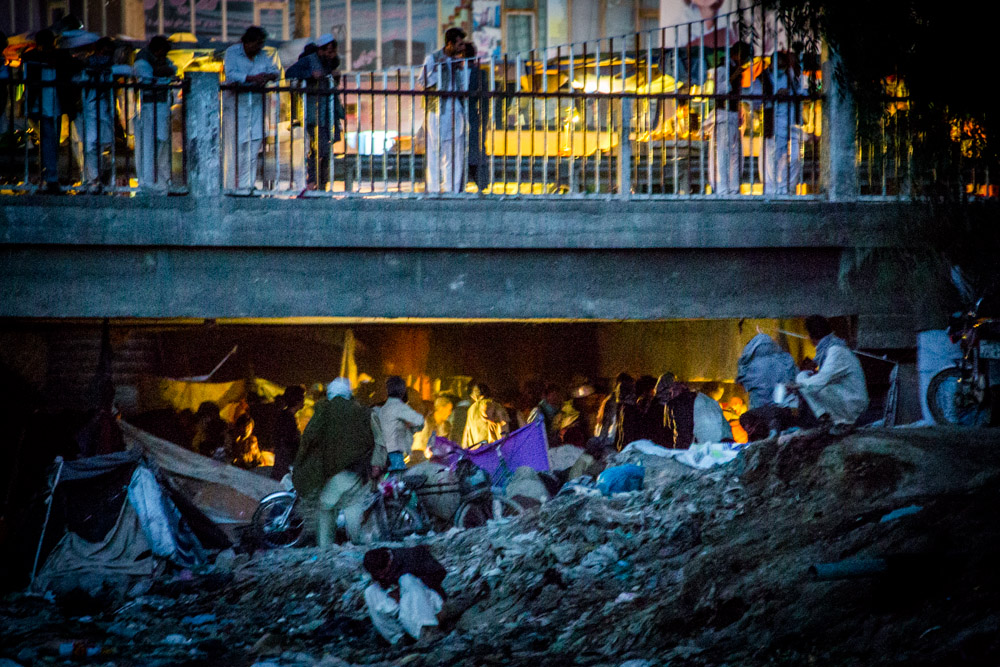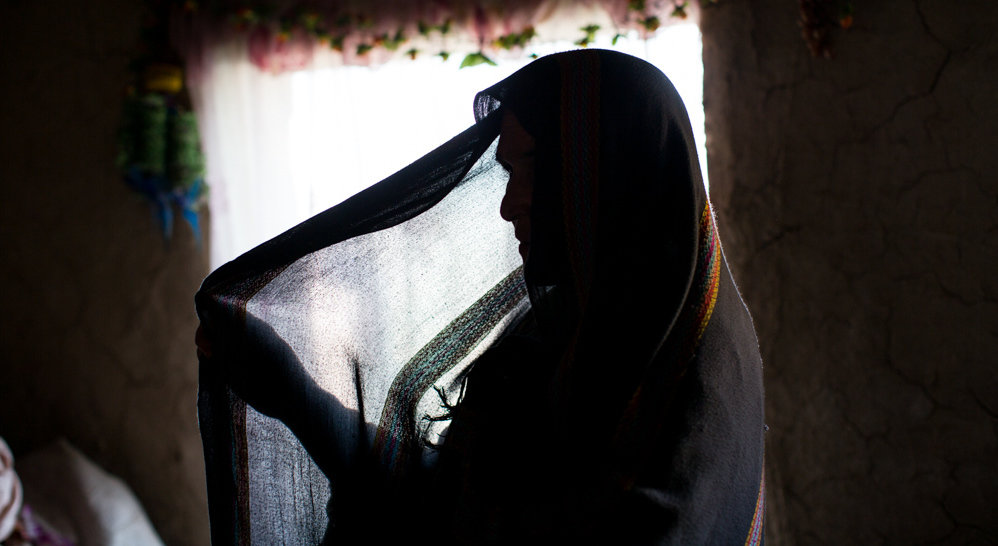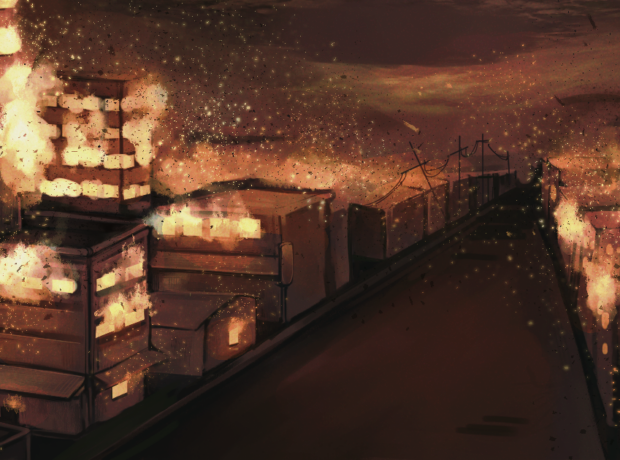I’m an aid worker and researcher, and most of my work involves figuring out how to get to the most vulnerable persons with the right assistance, at the right time, in the right way.
In conflict zones, the most vulnerable people are usually in areas that are dangerous and remote, not necessarily in the centre of fighting, but often in areas inaccessible to state welfare and international aid. Usually this is because an armed group controls or contests the area or road, which brings challenges for front-line aid organisations attempting to reach those in need. But there are other challenges too.
In Afghanistan, ‘pockets of exclusion’ are not just geographic, they’re social as well. Widows are one such group who desperately need support. To better inform the aid community, to drive discussion, and to improve the collective response for widows’ welfare in Afghanistan, I spent a month photographing and documenting their situation, speaking with them and others about their experiences.

A widow walks downhill to her home in a poor suburb of Kabul
At first, I interviewed women who begged in the street or who had fled to informal settlements, tiny, makeshift homes usually in ‘camps’ for the internally displaced. The conditions were pretty rough and their stories, predictably, depressing. One widow, sixty years old, told me:
“For seven years we’ve been living on this mountain. My husband died in a bomb blast in Kandahar when we were living there. I have two sons and five daughters. We were helped three years ago with a sack of wheat but after that no one has helped us. I cannot work because I am old and my eye sight is also weak. I went to the clinic but I couldn’t buy glasses because I didn’t have enough money. I have 5 daughters, 4 of them are married and one is living with me, but they cannot help me because their conditions are bad too.”
Another widow, sixty-five years old, had never received any assistance:
I have eight children. My husband died eleven years ago of a heart attack. I beg on Fridays in front of the nearby mosque. I didn’t receive any aid from any organisation. The most important help we want is food.

A widow begs on a busy road in Kabul; the two loaves of bread she now has are the dinner for her family of eight.
Most of those I talked to, however, were more recently widowed, in their thirties or forties, their husbands killed in an explosion somewhere, or a firefight, or simply by natural causes. They had no work, no welfare, and were still finding their feet. They were helpless, desperate. One widow, fifty-five years old, told me:
“After my husband died we lived in our previous house for one more year. But we were asked to leave by local government who wanted the land; we were not paid a penny. I now wash clothes and earn 150 to 250 Afghani (3 to 5 US dollars) in a week or two. I have liver disease, and pains in my hands and feet. I went to the doctor twice; they prescribed me medicines, but I don’t have enough money to pay for the basic treatment. It costs about 20,000 Afghani (400 US dollars). No one helped me before. You’re the first person who asked about us and came to our house.”
As I looked closer I realised that there were gradations of desperation, and that these widows living on the abject ‘poverty line’ were relatively well-off, the least wretched perhaps of the most desperate, and that the situation for some could sink much further. I followed the story, down. The journey took me to some darker places.
Realising that some widows had turned to prostitution and drug addiction, I asked an Afghan woman who had been (uniquely) rehabilitating drug addicts for the past five years, to introduce me to women she knew. We went to meet widows in a heroin den in southern Kabul. They had become slaves to the habit: a simple, yet oppressive, escapism. It was a miserable and dangerous place; under a bridge, dotted with crouching figures, with dealers dashing around farming their ‘clients’, the stream flowing with human waste, used syringes and probably hepatitis.

Under the Bridge
As dusk settled, small flames dancing like little candles could be seen from the huddles of clothes; it felt as if it was their souls faintly flickering. In a corner there were four women crouched around a baby. One woman was lighting up. I could see that another of the women, under her blue burqa, was wearing pink high heels. She stood up and stumbled away when I started to approach.
I began to research the issue more deeply, to try to understand the plight of these Afghan widows, the sources of the suffering and the limitations of our responses.
Understanding Widowhood in Afghanistan
Widows are overlooked and desperate in Afghanistan. Of course, the social situation for all women in Afghanistan is poor; the country has a Gender Inequality Index (GII) value of 0.705, ranking it 169 out of 187 countries in the 2013 Human Development Index. The humanitarian response in Afghanistan is catching up to some of these differences: more assistance is allocated for ‘women-headed households’, but many widows are falling between the cracks in the system.
A 2013 study by CARE International found that of 194 humanitarian projects in Afghanistan, comprising US$350m of funds, a quarter were gender-blind (i.e. took no visible steps to address gender issues), and two thirds only had basic elements addressing gender concerns. More recently, there have been some advances. This year, of the 21 projects approved (as of November 2014) for funding under the 2015 Afghanistan Common Humanitarian Fund, half contributed significantly to gender equality. Although only one had a principal purpose of advancing gender equality. The aid community is humble about its ignorance, but there is little progress in rectifying this:
“Capacity, security and access constraints already create significant data deficits in Afghanistan’s humanitarian response planning and severely limit the required gender analysis. Context specific analysis of gender concerns is further challenged by the lacking internalisation or conceptual understanding of gender among partners, and further constricted by the lack of female staff at all levels, especially in rural and remote areas.”

A widow crouches outside of her tiny, makeshift home
What is missing is not the understanding of needs that differ by sex and age; it is generally accepted that more assistance should be given for women. What’s missing is an understanding of how women and girls, even if they are allocated more assistance, can access that assistance—the more precise idea, of how to provide assistance, is poorly understood. Assumptions that women can—in the same way as their male counterparts in Afghanistan—access assistance and then transport it back home and use it in its intended way, need to be interrogated. Socio-cultural norms and domestic/community patriarchal control in Afghanistan affect female freedom of movement, engagement, participation and even communication. Can females travel independently to sites where they are registered for, and later receive, help? Do they have enough money or the male accompaniment to transport the assistance home? When the assistance does get home, who eats it, or spends it, or sells it? Can they seek support to resolve this, or even complain?
False assumptions
Some of the assumptions that assistance programmes are founded upon are misjudged, and it is hard to see whether the aid is really reaching the most vulnerable women.
Widows are a case in point. According to Sharia teachings, widows only get an eighth of the inheritance from their spouse’s death if the husband has children (if not, one quarter). The rest is distributed amongst other family members. And widows rarely qualify for support if they have a son aged 18 years or older, but an adult son is no guarantee that a widow will be supported by her family. The poorest widows can be bankrupted simply by the funeral costs—a forty year old widow told me:
“My husband died nine months ago here in this tent. I have seven children: I have four sons and three daughters. I earn money by washing clothes. No one helped us yet. We need food more than medicine. I borrowed more than 50,000 Afghanis (1000 USD) for my sickness and my husband’s funeral.”

A widow explains how her original home was taken after her husband died.
Counter-intuitively, remarried widows are generally more vulnerable than those who are not. Remarried widows generally do not qualify (under ‘targeting’ or ‘beneficiary selection’ criteria, as they are not technically in a ‘female-headed household’) for a lot of the social protection systems, including local charitable welfare, international humanitarian, or community-based support, which they would otherwise. The situation for these widows is perhaps worse than if they were not remarried; “the resilience of Afghan widows stems from their new-found independence” a local field researcher told me. But a remarried widow is no longer independent—she does not enjoy the same personal freedoms to work, to interact socially and this new-found social capital is an important part of their resilience.
It is customary for widows to be remarried to their brother-in-laws; “the ‘shame’ of the family needs to be kept inside the family”. But from the brother-in-law’s perspective, often the widow is still viewed as their brother’s wife, and is not treated as if the brother-in-law’s actual wife, regardless of whether the remarried widow is the first or second wife of the brother-in-law. Of course, neither does the brother-in-law have a choice in whether to marry the widow—customs affect both genders. But widows and their daughters are often not financially supported, particularly if the brother-in-law is also poor. A remarried widow’s sons may, however, get preferential treatment as a nephew who will eventually start earning for his new family.
Desperation and systemic abuse
As with other vulnerable groups, many try to help, but some abuse these positions of power. Government branch personnel in Afghanistan dealing with social protection do not always work in the best interest of widows. Afghanistan, this year, is rated as one of the five most corrupt countries in the world according to Transparency International. Some of the mechanisms used to select Afghan widows as beneficiaries are easily abused. Anecdotally, I have heard that many women registered as widows to receive assistance are merely female relatives of local community elders entered onto the list. There is a need to better understand how endemic this issue really is.
Illiteracy and lack of worldly awareness are significant challenges to widows accessing assistance; they act as barriers to them properly understanding what is available, how and why. The influence of (predominantly male) community elders affects who is selected and registered for assistance when humanitarian needs assessments take place, or what happens after aid is distributed. Local civil service staff responsible for registration anecdotally require ‘tips’ to ‘expedite’ a registration process which qualifies the widow for receiving assistance. The registration might otherwise, it seems, take an eternity.
It gets worse. Some of the Afghan widows have said that they have occasionally been asked or required to perform sexual favours to representatives of local government branches in order for the official to register them for assistance and social protection. Widows seemingly lack voice to speak out about such social injustice. Indeed, widows are silenced, in that their complaints are often not taken seriously. If it was a serious complaint or allegation, “people would first point fingers at them,” they feel.
Widows are more sexually vulnerable than other women in Afghan society, in that they enjoy less protections. A girl is a virgin whom fathers and brothers defend, and married women are wives guarded by husbands, but widows have neither of these protections. This vulnerability, combined with economic desperation, is financially exploited. Prostitution is often facilitated locally, within communities; there are no apparent organised criminal networks controlling and profiting from prostitution. Widows solicit, and local men are the ‘customers’. Often the ‘Wakil’, the main community representative or elder for the area, will broker the arrangement, making introductions and taking some of the payment as fee.

A begging widow’s shoe, ‘mended’ with a cigarette packet.
The average customer is in his early 30s, mostly unmarried, relatively educated, often even to undergraduate level. They generally pay between 200 and 500 AFN (between four and ten dollars) for the widow’s services. Many men cannot afford to marry (in Afghanistan, despite the low socio-economic status of the majority of the population, marriage ceremonies can often cost more than 10,000 USD) or they were forcibly married in the first place to wives they perhaps neither loved nor were attracted to. So, there is less shame in engaging in prostitution for the male customers than there is for the widows, who feel deeply ashamed of their desperation. It is unfortunate that relief is not provided for these most desperate souls, that aid does not explicitly target more vulnerable sub-groups such as widowed prostitutes, who rarely receive any assistance.
Oppressive escapism
There is a vicious cycle at play, a ‘slippery slope’. Widowhood can often bring poverty, which widows struggle to deal with. Some eventually resort to prostitution to make ends meet. Some widows who engage in prostitution resort to drug use, supposedly as a release for their depression, a solution for their shame. Addiction to crystal meth, heroin, opium, alcohol sometimes follows.
These are perhaps the most vulnerable category of widows and, from what I saw, it is rare that they have access to humanitarian assistance.It’s rare too for aid agencies to gain access to them. Other than the Afghan woman I met who single-handedly attempted to rehabilitate drug addicts and guided me through the heroin dens under the bridge, the addicts had never seen any aid agencies or state welfare visit these areas.
Not all of these widows became addicted to drugs after their husbands died. Some had already been forced into prostitution by their drug-addicted husbands to pay for their habits, and sometimes they fell foul of the addiction too. Widows who have become drug addicts and prostitutes are often paid in small amounts of drugs. Their customers are often drug addicts themselves.
It is doubly hard for women to break out of this system or cycle of drugs and prostitution, even if they have the willpower to do so. It is not in the interests of the drug gangs or their ‘clients’ to let them leave. My Afghan guide, a widow herself, lost her brother to drug addiction and so began to work on rehabilitation projects. When she started trying to rehabilitate other drug addicted widows, she was attacked in her home by a local drug gang, incensed that she had decreased their steady income. They garrotted her and left her bleeding from her neck and mouth. No prosecutions were brought. The US embassy later offered her asylum, but she refused, preferring to continue her outreach work on drug addiction rehabilitation.
Reconsidering the response
Providing effective humanitarian assistance is not simply about reaching beneficiaries at the point of aid distribution. More careful work is required to confirm whether beneficiaries are selected appropriately, and that programmatic assumptions are correct.
Whether the poorest widows are being reached by assistance is a good litmus test for the fitness of a humanitarian response. The ability of state welfare and international aid agencies to operate ‘at scale’ is bittersweet here. Implementing aid programmes to reach the hundreds of thousands often leads to loss of focus on how to reach the thousands of ‘most vulnerable’. The trade-off between operating ‘at scale’ and ‘with quality’ is palpable, and the challenge for the aid and welfare communities to overcome is to balance the imperative to work ‘at scale’ for the vulnerable, but also ‘with quality’ for the most vulnerable. For most of the widows I had met, a low or medium quality response would unlikely reach them.

Widows in a camp for ‘internally displaced persons’ in Kabul
Humanitarian responses and welfare systems would do well to not only look at the numbers, but also to look at the faces and testimonies of women in need. Ethnographic validation needs to accompany quantitative-based decision-making in responding to women and widows. Gender analysis therefore is just as important as ever, but we need to be more focused and daring in order to make structural breakthroughs to understanding and responding to women’s needs. For example, the logic of humanitarian access should not end simply at the point of distribution, when the aid agency meets the beneficiary and transfers assistance. We need to look at what happens after distribution to confirm whether our assistance did—at a micro-level—reach those it was intended to reach. Better informed programme design is required to ensure that, after assistance has been transferred, it is still effectively accessed by beneficiaries. Is it taken? Is it sold, or taxed? Is it left behind if the widow is displaced?
I’m still scratching the surface, both in terms of field research and documentary photography. This is really the tip of the iceberg. More needs to be done, beyond a self-funded, month-long documentary photo project. But my intention at this point is to help uncover these untold human stories of suffering and marginalisation, and drive discussion amongst practitioner communities and policy circles for ‘action learning’ to better the response to, and lot of, widows in Afghanistan. In the future, I hope to pursue further and more extensive documentary photography work and action research on some of the subjects touched upon here, to support social justice for Afghan widows.



